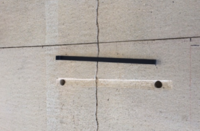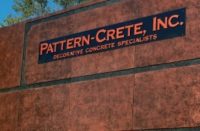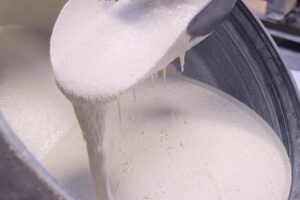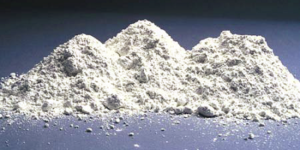 Ninety-nine percent of the cement used in the United States is gray. The other 1 percent is a startlingly bright white color. Because it represents such a small share of the market, many contractors know little about white cement concrete.
Ninety-nine percent of the cement used in the United States is gray. The other 1 percent is a startlingly bright white color. Because it represents such a small share of the market, many contractors know little about white cement concrete.
Portland cement’s ordinary gray color comes from iron oxide and, to a much lesser degree, manganese oxide. These metals are usually present in the limestone, clays, and gypsum used to make the cement, and iron is typically added as a flux during the manufacturing process. To eliminate the gray color, manufacturers select raw materials that are naturally low in iron and manganese, and they process the materials without adding iron. These steps keep the iron content below ½ percent rather than the 3 percent to 6 percent typically found in gray cement.
Why use it?
White cement concrete has basically the same physical properties as gray concrete, so the color difference is the most obvious reason for using the white product. In its pure form, it provides a striking contrast with its surroundings. Coloring it can produce soft pastels or bright blue colors that cannot be achieved with gray concrete.
“I often use a white cement overlay because you can get really vibrant colors with it,” says Levi Susoev, owner of River Alloy Designs in Kerman, Calif. Susoev showcased his techniques at the Artistry in Decorative Concrete demo at World of Concrete this January. He created a Mardi Gras mask design featuring iridescent blue, soft pinks and yellows, and transparent gray colors.
“Consistency is one of the biggest reasons that you would want to use it,” says Larry Rowland, manager of marketing and technical services for Lehigh Cement Company in Allentown, Pa. The quality of gray cement is carefully controlled for performance characteristics, but not for color, which can vary significantly. When white cement is made, the color is also carefully monitored. “People will even utilize white cement to make a gray product,” Rowland says. “They could make that gray product with gray cement, but when they have to go and match it six months from now or a year from now, it may not match.”
Besides its visual appeal, white concrete reflects twice as much light as gray concrete. “We use a significant amount for full-thickness concrete floors we install for a large, regional supermarket chain,” says Curt Meidling, operations manager for Meidling Concrete Inc. of Spokane, Wash. Along with the white floors, the stores have many skylights. The increased brightness allows the owners to cut their lighting costs significantly. “Those benefits are outweighing the added initial cost,” Meidling says.
What are the drawbacks?
The main disadvantage is that white cement is more expensive than gray. Jamie Farny, program manager for masonry and special products for the Portland Cement Association, offers several reasons. One is the scarcity of suitable raw materials. Another is increased manufacturing costs. Because of the very low iron content, the raw materials must be processed at a higher temperature and remain in the kiln longer, resulting in higher energy costs and longer production times. Another factor that can increase the in-place cost is the need to use very light-colored — or even white — fine and coarse aggregates to make white concrete. Finally, Farny says, “Because it is a premium product, manufacturers are asking for money because they have a certain expertise.”
Just how much more expensive is it? Differences vary regionally because of local styles and availability of materials. However, Rowland offers some general comparisons. “If you’re just buying a bag off the shelf, it could cost two to three times as much as gray cement. But the labor’s the same and the mixing’s the same, so the in-place costs dilute that increase. In-place costs for white concrete ready-mix are probably 20-30 percent more.”
Mike Cline, owner of Clinecrete, Inc., of Commerce, Ga., uses a couple of alternative techniques to control overall cost. On some projects, he applies a white cement overlay on a gray concrete base. On others, he pours a gray concrete base and then applies a white color hardener made by L.M. Scofield Company. “You can get a good, clear white that way if you know how to do it,” Cline says. “But it’s not something you’d just tell Joe Finisher who’s never done decorative concrete to do.”
For integrally colored concrete, using white cement can reduce the amount of pigment needed by as much as a factor of ten. Furthermore, Rowland says, “It costs the contractor less in comebacks because the color’s going to match each time. It takes less time to formulate, and they don’t have to go back and fix it because it didn’t match.”
“The cost also depends on how willing the contractor is to work with that material and how prepared they are,” Farny adds. “There’s a lot of extra care that is required to make this, whether it’s cleaning out trucks or preventing contamination or tying up a truck that’s going to have to offload very slowly. If you’re doing work where appearance is very important, people are often taking more care, so it might take a little longer.”
The extra care that is required for white concrete can be viewed as a disadvantage. Contamination must be avoided, which may mean waiting to pour a floor until after the building’s walls and roof are completed. Frequently, larger crews are needed because white concrete sets up somewhat faster than gray and must be hand-finished to get good results. And the finishers must be experienced with white concrete. Because the paste portion carries the color, bringing paste to the surface makes white concrete appear whiter and more reflective, and intensifies the color of pigmented concrete surfaces. “You have to take a lot more special care in finishing, so you don’t overfinish it and basically burn it and darken the color,” says Meidling. “That can be real tricky, especially during warmer weather conditions.”
Curing can also be tricky. Since plastic sheeting tends to not lie flat on the surface and may allow discoloration, some contractors protect the surface with nonstaining waterproof paper or plastic-coated burlap with thoroughly taped seams. Other contractors cover the freshly troweled surface with a dissipating curing membrane. If placed in an enclosed building with insufficient sunlight exposure, however, the membrane will have to be removed mechanically.
Making the choice
Some contractors may regard the extra care required for installing white concrete a burden, but others see it as an opportunity to do interesting, high-quality work. “As a product that not just anybody can do well, it commands a level of craftsmanship,” Farny says. “It is something that people can be proud of.”
















